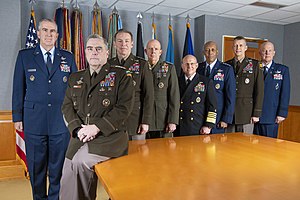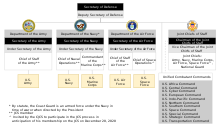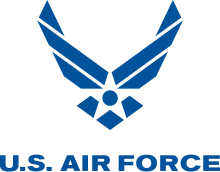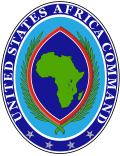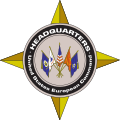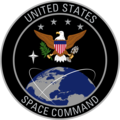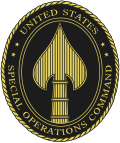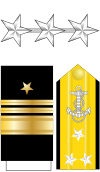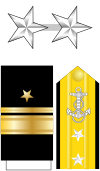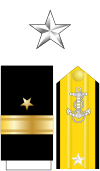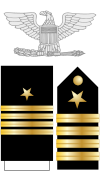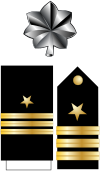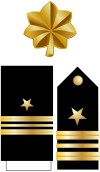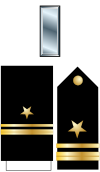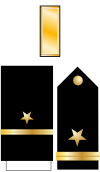A | B | C | D | E | F | G | H | CH | I | J | K | L | M | N | O | P | Q | R | S | T | U | V | W | X | Y | Z | 0 | 1 | 2 | 3 | 4 | 5 | 6 | 7 | 8 | 9
| United States Armed Forces |
|---|
 |
| Executive departments |
| Staff |
| Military departments |
| Military service branches |
| Command structure |
The United States Armed Forces are the military forces of the United States.[10] The armed forces consists of six service branches: the Army, Marine Corps, Navy, Air Force, Space Force, and Coast Guard.[11][12] The president of the United States is the commander-in-chief of the armed forces and forms military policy with the Department of Defense (DoD) and Department of Homeland Security (DHS), both federal executive departments, acting as the principal organs by which military policy is carried out. All six armed services are among the eight uniformed services of the United States.[13]
From their inception during the American Revolutionary War, the U.S. Armed Forces have played a decisive role in the history of the United States. They helped forge a sense of national unity and identity through victories in the First Barbary War and the Second Barbary War. They played a critical role in the American Civil War, keeping the Confederacy from seceding from the republic and preserving the union. The National Security Act of 1947, adopted following World War II, created the modern U.S. military framework. The Act established the National Military Establishment, headed by the secretary of defense; and created the United States Air Force and the National Security Council. It was amended in 1949, renaming the National Military Establishment the Department of Defense, and merged the cabinet-level Department of the Army, Department of the Navy, and Department of the Air Force, into the Department of Defense.
The U.S. Armed Forces are one of the largest military forces in terms of personnel. They draw their personnel from a large pool of professional volunteers. Although military conscription has been used in the past, it has not been used in the U.S. since 1973. The Selective Service System retains the power to conscript males, and requires that all male citizens and residents residing in the U.S. between the ages of 18–25 register with the service.
The U.S. Armed Forces are considered the world's most powerful military.[14] The military budget of the United States was US$693 billion in 2019, the highest in the world.[15] In 2018, that accounted for 36 percent of the world's defense expenditures. The U.S. Armed Forces has significant capabilities in both defense and power projection due to its large budget, resulting in advanced and powerful technologies which enables a widespread deployment of the force around the world, including around 800 military bases outside the United States.[16] The U.S. Air Force is the world's largest air force, while the U.S. Army Aviation Branch is the second largest. The U.S. Naval Air Forces is the fourth largest air arm in the world and is the largest naval aviation service, while U.S. Marine Corps Aviation is the world's seventh largest air arm.[17] The U.S. Navy is the world's largest navy by tonnage.[18] The U.S. Coast Guard is the world's 12th largest maritime force.[19] The U.S. Space Force is the world's only active independent space force.[20][21]
History
The history of the U.S. Armed Forces dates back to 14 June 1775, with the creation of the Continental Army, even before the Declaration of Independence marked the establishment of the United States.[22] The Continental Navy, established on 13 October 1775, and Continental Marines, established on 10 November 1775, were created in close succession by the Second Continental Congress in order to defend the new nation against the British Empire in the American Revolutionary War.[23][24]
These forces demobilized in 1784 after the Treaty of Paris ended the Revolutionary War. The Congress of the Confederation created the current United States Army on 3 June 1784.[22] The United States Congress created the current United States Navy on 27 March 1794 and the current United States Marine Corps on 11 July 1798.[23][25] All three services trace their origins to their respective Continental predecessors. The 1787 adoption of the Constitution gave Congress the power to "raise and support armies", to "provide and maintain a navy" and to "make rules for the government and regulation of the land and naval forces", as well as the power to declare war. The President of the United States is the U.S. Armed Forces' commander-in-chief.[26]
The United States Coast Guard traces its origin to the formation of the Revenue Cutter Service on 4 August 1790, which merged with the United States Life-Saving Service on 28 January 1915 to establish the Coast Guard.[27][28] The United States Air Force was established as an independent service on 18 September 1947; it traces its origin to the formation of the Aeronautical Division, U.S. Signal Corps, which was formed 1 August 1907 and was part of the Army Air Forces before being recognized as an independent service in the National Security Act of 1947.[29] The United States Public Health Service Commissioned Corps was formerly considered to be a branch of the United States Armed Forces from 29 July 1945 until 3 July 1952, and is now one of the eight uniformed services of the United States [30]
The United States Space Force was established as an independent service on 20 December 2019. It is the sixth branch of the U.S. military and the first new branch in 72 years.[31] The origin of the Space Force can be traced back to the Air Force Space Command, which was formed 1 September 1982 and was a major command of the United States Air Force.[32]
Structure
Presidential command over the U.S. Armed Forces is established in Article II in the Constitution whereby the president is named as the "Commander in Chief of the Army and Navy of the United States, and of the Militia of the several States, when called into the actual Service of the United States."[33] The United States Armed Forces are split between two cabinet departments, with the Department of Defense serving as the primary cabinet department for military affairs and the Department of Homeland Security responsible for administering the United States Coast Guard.[34]
The military chain of command flows from the President of the United States to the secretary of defense (for services under the Defense Department) or secretary of homeland security (for services under the Department of Homeland Security), ensuring civilian control of the military. Within the Department of Defense, the military departments (Department of the Army, United States Department of the Navy, and Department of the Air Force) are civilian led entities that oversee the coequal military service branches organized within each department. The military departments and services are responsible for organizing, training, and equipping forces, with the actual chain of command flowing through the unified combatant commands.[35]
The Joint Chiefs of Staff, although outside the operational chain of command, is the senior-most military body in the United States Armed Forces. It is led by the Chairman of the Joint Chiefs of Staff, who is the military head of the armed forces and principal advisor to the president and secretary of defense on military matters. Their deputy is the Vice Chairman of the Joint Chiefs of Staff. Other members include the chief of staff of the Army, commandant of the Marine Corps, chief of naval operations, chief of staff of the Air Force, chief of space operations, and the chief of the National Guard Bureau.[36] The commandant of the Coast Guard is not an official member of the Joint Chiefs, but sometimes attends meetings as the one of the military service chiefs. The Senior Enlisted Advisor to the Chairman is the most senior enlisted member in the United States Armed Forces.[37]
Leadership of the Armed Forces, to include the president of the United States, Secretary of Defense, Secretary of Homeland Security and Chairman of the Joint Chiefs of Staff are members of the United States National Security Council, which advises the president on national security, military, and foreign policy matters.[38] The National Security Advisor, Homeland Security Advisor, and the Deputy National Security Advisor may also be members of the United States Armed Forces.[39][40] The National Security Council Deputies Committee also includes the Deputy Secretary of Defense, Deputy Secretary of Homeland Security, and Vice Chairman of the Joint Chiefs of Staff.[41] Military leadership, including the Secretary of Defense, United States Secretary of Homeland Security, and Chairman of the Joint Chiefs of Staff also sit on the National Space Council.[42]
Service branches
The United States Armed Forces is composed of six coequal military service branches. Five of the branches, the United States Army, United States Marine Corps, United States Navy, United States Air Force, and United States Space Force are organized under the Department of Defense's military departments. The United States Coast Guard is nominally under the Department of Homeland Security, but may be transferred to the Department of Defense's Department of the Navy (which is the civilian entity that oversees the coequal U.S. Marine Corps and U.S. Navy) at the direction of the president or congress. With the exception of the Coast Guard, the military services only organize, train, and equip forces. The unified combatant commands are responsible for operational control of non-service retained forces.
Army
The United States Army (USA) is the land service branch of the United States Armed Forces and part of the civilian-led Department of the Army, which is led by the Secretary of the Army. The military head of the U.S. Army is the chief of staff of the Army, who is assisted by the vice chief of staff of the United States Army and sergeant major of the Army. It was founded on 14 June 1775 as the Continental Army.
The five core competencies of the Army are to conduct:[43]
- Prompt and sustained land combat
- Combined arms operations
- Combined arms maneuver and wide area security
- Armored and mechanized operations
- Airborne and air assault operations
- Special operations
- Set and sustain the theater for the joint force
- Integrate national, multinational, and joint power on land
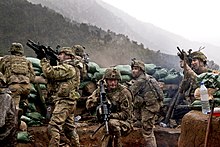
The U.S. Army is composed of the Regular Army, United States Army Reserve, and United States Army National Guard. The U.S. Army is organized into four army commands, which conduct the majority of the service's organize, train, and equip functions, ten Army service component commands, which command forces attached to the combatant commands, and twelve direct reporting units. The Army also organizes its personnel into 21 different basic branches.[44]

The four army commands are:
 United States Army Forces Command: Provides Army forces to combatant commanders.
United States Army Forces Command: Provides Army forces to combatant commanders. United States Army Training and Doctrine Command: Recruits, trains, and educates soldiers and develops Army doctrine.
United States Army Training and Doctrine Command: Recruits, trains, and educates soldiers and develops Army doctrine. United States Army Materiel Command: Develops, maintains, and acquires systems and materiel.
United States Army Materiel Command: Develops, maintains, and acquires systems and materiel. United States Army Futures Command: Modernization and future systems development.
United States Army Futures Command: Modernization and future systems development.
The U.S. Army's field structure is broken into several subdivisions under its commands:[45]
|
|
Army group: Only used during large scale wars or as part of multinational commands, consist of four to five field armies and 400,000 to 1 million soldiers. Usually responsible for directing campaigns in a certain geographical area and commanded by a general | ||||
|
|
Field army: Consists of two or more corps or more than four divisions and consists of up to 90,000 soldiers commanded by a general or lieutenant general. | ||||
|
|
Corps: Consists of two to five divisions and 20,000 to 45,000 soldiers commanded by a lieutenant general. A corps is the highest level of command that provides operational direction for combat operations, with higher levels concerned with administration rather than operations. | ||||
|
|
Division: Consists of three to four brigades and 10,000 to 15,000 soldiers commanded by a major general and are subdivided into airborne, armored, infantry, and mountain divisions. Each division conducts major tactical operations and sustained battlefield operations. | ||||
|
|
Brigade / Regiment / Group: Consists of two to three battalions and 3,000 to 5,000 soldiers commanded by a colonel. Armored and Ranger units are organized into regiments and Special Forces are organized into groups. In 2016, the Army reorganized its brigades into brigade combat teams, which are autonomous modular brigades that most commonly include one combat arms brigade and its assigned support and fire units. | ||||
|
|
Battalion / Squadron: Consist of four to six companies and consist of up to 1,000 soldiers commanded by a lieutenant colonel. Battalions are organized into combat arms battalions, combat support, and combat service support battalions by unit type. Armored and air cavalry are organized into squadrons. Battalions and squadrons conduct independent operations of limited scope and duration. | ||||
|
|
Company / Battery / Troop: Consist of three to four platoons and a few dozen to 200 soldiers commanded by a captain. Artillery is organized into batteries and armored and air cavalry units are organized into troops. Companies, batteries, and troops are tactical-sized units that can perform a battlefield function on its own. | ||||
|
|
Platoon: Consists of two to three squads and up to 36 soldiers led by a first lieutenant or second lieutenant. | ||||
|
|
Squad / Section: Consists of two teams and four to ten soldiers led by a staff sergeant. | ||||
|
|
Team: Consists of four soldiers and led by a sergeant or corporal. |
Marine Corps
The United States Marine Corps (USMC) is the maritime land force service branch of the United States Armed Forces and part of the civilian-led Department of the Navy, which is led by the Secretary of the Navy. The military head of the U.S. Marine Corps is the commandant of the Marine Corps, who is assisted by the assistant commandant of the Marine Corps and sergeant major of the Marine Corps. The Marine Corps was founded on 10 November 1775 as the Continental Marines and disbanded in 1783, before being reestablished as the United States Marine Corps on 11 July 1798.[46]

The Marine Corps is responsible for amphibious warfare and expeditionary warfare operations, having a very close relationship with its coequal sister service, the United States Navy. The U.S. Marine Corps is composed of the Regular Marine Corps and the United States Marine Corps Reserve. The central unit of the Marine Corps is a Marine Air-Ground Task Force, which consist of a command element, ground combat element, aviation combat element, and logistics combat element. The Marine Corps is divided in the Fleet Marine Force and the Supporting Establishment.
The Fleet Marine Force includes:
 United States Marine Corps Forces Command / Fleet Marine Force, Atlantic: Conducts operations in the Atlantic, Europe, and Africa. Fleet Marine Force, Atlantic under the command of United States Fleet Forces Command.
United States Marine Corps Forces Command / Fleet Marine Force, Atlantic: Conducts operations in the Atlantic, Europe, and Africa. Fleet Marine Force, Atlantic under the command of United States Fleet Forces Command. United States Marine Corps Forces, Pacific / Fleet Marine Force, Pacific: Conducts operations in the Pacific and Middle East. Fleet Marine Force, Pacific under the command of United States Pacific Fleet.
United States Marine Corps Forces, Pacific / Fleet Marine Force, Pacific: Conducts operations in the Pacific and Middle East. Fleet Marine Force, Pacific under the command of United States Pacific Fleet.

The U.S. Marine Corps' Marine Air-Ground Task Force structure is broken into several levels under the Fleet Marine Force:[47]
| Marine Expeditionary Force: The largest type of Marine Air-Ground Task Force, consists of a marine division, air wing, and logistics group under a headquarters group and 20,000 to 90,000 marines and sailors commanded by a lieutenant general. The principal warfighting organization of the Marine Corps during larger crisis or contingencies, MEFs' are self-sufficient for 60 days.[48] | |
| Marine Expeditionary Brigade: The medium type of Marine Air-Ground task Force, consists of a reinforced infantry regiment, reinforced composite marine aircraft group, and task organized logistics combat regiment under a command element and 20,000 marines and sailors commanded by a brigadier general. Forward deployed MEUs provide an expeditionary force in readiness and are self-sufficient for 30 days.[48] | |
| Marine Expeditionary Unit: The light type of Marine Air-Ground task Force, consists of a reinforced infantry battalion, reinforced composite aviation squadron, and task organized combat logistics battalion command element and 2,600 marines and sailors commanded by a colonel. Forward deployed MEUs provide an expeditionary force in readiness, capable of commencing missions on a six-hour timeline and are self-sufficient for 15 days.[48] |
The U.S. Marine Corps' unit structure is broken into several subdivisions under the Fleet Marine Force:[47]
|
|
Marine division / Marine aircraft wing: Consists of three marine regiments or marine aircraft groups and 6,561 marines commanded by a major general. | ||||
|
|
Marine logistics group: Consists of three combat logistics regiments and commanded by a brigadier general. | ||||
|
|
Marine regiment / Marine aircraft group: Consist of three or more marine battalions or marine aviation squadrons and 2,187 marines commanded by a colonel. | ||||
|
|
Marine battalion / Marine aviation squadron: Consists of three or more companies or 24 aircraft and 729 marines commanded by a lieutenant colonel. | ||||
|
|
Company: Consists of three or more platoons and 243 marines commanded by a Captain. | ||||
|
|
Platoon: Consists of three squads and 27 marines commanded by a first lieutenant or second lieutenant. | ||||
|
|
Squad / Section: Consists of three teams and nine marines led by a sergeant. | ||||
|
|
Fire team: Consists of four marines led by a corporal. |
The United States Navy (USN) is the maritime service branch of the United States Armed Forces and part of the civilian-led Department of the Navy, which is led by the Secretary of the Navy. The military head of the U.S. Navy is the chief of naval operations, who is assisted by the vice chief of naval operations and master chief petty officer of the Navy. The Navy was founded on 13 October 1775 as the Continental Navy, which was disbanded on 1 August 1785 before being reestablished as the modern U.S. Navy on 20 January 1794.[49]
The five enduring functions of the Navy are:[50]
The U.S. Navy is composed of the Regular Navy and United States Navy Reserve. The U.S. Navy is organized into eight navy component commands, which command operational forces, fifteen shore commands, which support the fleets' operating forces, five systems commands, which oversee the technical requirements of the Navy, and nine type commands, which administratively manage units of a certain type.
The navy component commands are:[51]
 United States Fleet Forces Command / United States Naval Forces Northern Command / United States Naval Forces Strategic Command: Conducts naval operations in North America as United States Northern Command's joint force maritime component and strategic deterrence operations as United States Strategic Command's joint force maritime component.
United States Fleet Forces Command / United States Naval Forces Northern Command / United States Naval Forces Strategic Command: Conducts naval operations in North America as United States Northern Command's joint force maritime component and strategic deterrence operations as United States Strategic Command's joint force maritime component. United States Pacific Fleet: Conducts naval operations in the Pacific and Asia as United States Indo-Pacific Command's joint force maritime component.
United States Pacific Fleet: Conducts naval operations in the Pacific and Asia as United States Indo-Pacific Command's joint force maritime component. United States Naval Forces Central Command: Conducts Naval operations in the Middle East as United States Central Command's joint force maritime component.
United States Naval Forces Central Command: Conducts Naval operations in the Middle East as United States Central Command's joint force maritime component. United States Naval Forces Southern Command: Conducts naval operations in South America as United States Southern Command's joint force maritime component.
United States Naval Forces Southern Command: Conducts naval operations in South America as United States Southern Command's joint force maritime component. United States Naval Forces Europe-Africa: Conducts naval operations in Europe and Africa as United States European Command's and United States Africa Command's joint force maritime component.
United States Naval Forces Europe-Africa: Conducts naval operations in Europe and Africa as United States European Command's and United States Africa Command's joint force maritime component. United States Fleet Cyber Command /
United States Fleet Cyber Command /  United States Navy Space Command: Naval component to United States Cyber Command and United States Space Command.
United States Navy Space Command: Naval component to United States Cyber Command and United States Space Command. United States Naval Special Warfare Command: Commands the United States Navy SEALs and conducts special operations as United States Special Operations Command joint force maritime component.
United States Naval Special Warfare Command: Commands the United States Navy SEALs and conducts special operations as United States Special Operations Command joint force maritime component. United States Navy Military Sealift Command: Conducts sealift operations as United States Transportation Command's joint force maritime component.
United States Navy Military Sealift Command: Conducts sealift operations as United States Transportation Command's joint force maritime component.
The U.S. Navy's unit structure is broken into several subdivisions under the operating force:[51]
- Numbered fleet: Elements of navy component commands led by vice admirals
- Task force: Scalable organization that is responsible to the fleet commander for assigned units and functions.
- Task group: An individual carrier strike group, amphibious ready group, surface strike group within a given fleet.
- Task unit: Units operating together for a specific task, such as air defense units within a carrier strike group.
- Task element: Individual units within a task unit.
The U.S. Navy's unit structure is broken into several subdivisions under the type command structure. For Naval Air Forces:[51]
|
|
Carrier air wing / Wing: Consists of four strike fighter squadrons, one electronic attack squadron, one carrier airborne early warning squadron, on helicopter sea combat squadron, one helicopter maritime strike squadron, and one fleet logistic support squadron under the command of a captain. | ||||
|
|
Squadron: Consists of several aircraft under the command of a commander. |
Air Force
The United States Air Force (USAF) is the air service branch of the United States Armed Forces and part of the civilian-led Department of the Air Force, which is led by the Secretary of the Air Force. The military head of the U.S. Air Force is the chief of staff of the Air Force, who is assisted by the vice chief of staff of the United States Air Force and chief master sergeant of the Air Force. It achieved independence on 18 September 1947 from the U.S. Army, but directly traces its history through the United States Army Air Forces, United States Army Air Corps, United States Army Air Service, the Division of Military Aeronautics, Aviation Section, U.S. Signal Corps, to the birth of Aeronautical Division, U.S. Signal Corps on 1 August 1907.

The five core missions of the Air Force are:[52]
- Air superiority
- Global integrated intelligence, surveillance and reconnaissance
- Rapid global mobility
- Global strike
- Command and control
The U.S. Air Force is composed of the Regular Air Force, United States Air Force Reserve, and United States Air National Guard. The U.S. Air Force is organized into nine major commands, which conduct the majority of the service's organize, train, and equip functions and command forces attached to the combatant commands.[53]

The Air Force's major commands are:
 Air Combat Command: Provides fighter, attack, intelligence, cyber, combat rescue, and air force ground forces to combatant commanders.
Air Combat Command: Provides fighter, attack, intelligence, cyber, combat rescue, and air force ground forces to combatant commanders. Air Education and Training Command: Recruits, educates, and trains airmen and develops Air Force doctrine
Air Education and Training Command: Recruits, educates, and trains airmen and develops Air Force doctrine Air Force Global Strike Command: Operates the Air Force's strategic bomber and intercontinental ballistic missile forces as United States Strategic Command's joint force air component.
Air Force Global Strike Command: Operates the Air Force's strategic bomber and intercontinental ballistic missile forces as United States Strategic Command's joint force air component. Air Force Materiel Command: Develops, maintains, and acquires systems and materiel.
Air Force Materiel Command: Develops, maintains, and acquires systems and materiel. Air Force Reserve Command: Manages Air Force reserve forces.
Air Force Reserve Command: Manages Air Force reserve forces. Air Force Special Operations Command: Conducts special operations with aviation and Special Tactics Commandos as United States Special Operations Command's joint force air component.
Air Force Special Operations Command: Conducts special operations with aviation and Special Tactics Commandos as United States Special Operations Command's joint force air component. Air Mobility Command: Conducts airlift and air refueling operations as United States Transportation Command's joint force air component.
Air Mobility Command: Conducts airlift and air refueling operations as United States Transportation Command's joint force air component. Pacific Air Forces: Conducts air operations as United States Indo-Pacific Commands joint force air component.
Pacific Air Forces: Conducts air operations as United States Indo-Pacific Commands joint force air component.
 United States Air Forces in Europe - Air Forces Africa: Conducts air operations as United States European Command's and United States Africa Command's joint force air component.
United States Air Forces in Europe - Air Forces Africa: Conducts air operations as United States European Command's and United States Africa Command's joint force air component.
The U.S. Air Force's field structure is broken into several subdivisions under its major commands:[54]
|
|
Numbered air force / Named air force: Consists of multiple wings with a geographic or functional assignment commanded by a general or lieutenant general. | ||||
|
|
Wing: Consists of two or more groups commanded by a brigadier general or colonel. Wings typically contain an operations group, maintenance group, mission support group, and a medical group. There are two types of wings: composite wings or objective wings. Composite wings operate more than one kind of aircraft and may be designated as self-contained units designed for quick air intervention anywhere in the world. Objective wings are based on a single purpose, such as an operational, air base, or specialized mission. | ||||
|
|
Group: Consists of two or more squadrons whose mission are similar or complementary commanded by a colonel. | ||||
|
|
Squadron: Consist of two or more flights commanded by a lieutenant colonel or major. | ||||
|
|
Flight: Consists of individual airmen, sections, or shops commanded by a captain. | ||||
|
|
Element / Section: Consists of two or more airmen led by a staff sergeant or senior airman. |
Space Force
The United States Space Force (USSF) is the space service branch of the United States Armed Forces and part of the civilian-led Department of the Air Force, which is led by the Secretary of the Air Force. The military head of the U.S. Space Force is the chief of space operations, who is assisted by the vice chief of space operations and senior enlisted advisor of the Space Force. It achieved independence on 20 December 2019 from the U.S. Air Force, but directly traces its history through Air Force Space Command to 1 September 1982, with even earlier history traced to the Western Development Division established on 1 July 1954.
The five core competencies of the Space Force are:[55]
- Space security
- Combat power projection
- Space mobility and logistics
- Information mobility
- Space domain awareness

The U.S. Space Force is composed of the Regular Space Force, not yet having organized a reserve component outside of the Air Force. The Space Force is organized into three field commands.[56]
The Space Force's field commands are:
 Space Operations Command: Conducts space, cyber, and intelligence operations as primary service component to United States Space Command.
Space Operations Command: Conducts space, cyber, and intelligence operations as primary service component to United States Space Command. Space Systems Command: Conducts research, development, acquisitions, and sustainment of Space Force systems.
Space Systems Command: Conducts research, development, acquisitions, and sustainment of Space Force systems. Space Training and Readiness Command: Conducts training, education, and doctrine development.
Space Training and Readiness Command: Conducts training, education, and doctrine development.
The Space Force's field structure is broken into several subdivisions under its field commands:[56]
|
|
Delta / Garrison: Consists of two or more squadrons, or attached Air Force mission support and medical groups for garrisons and wings and a Space Force operations group for wings as well, commanded by a brigadier general or colonel. Deltas are responsible for executing a specific mission, while garrisons are responsible for installations support and management. Space Force wings are a legacy organizational structure inherited from the Air Force that manage a singular base and mission under one organization and are being phased out in favor of deltas and garrisons. | ||||
|
|
Squadron: Consist of two or more flights commanded by a lieutenant colonel. | ||||
|
|
Flight / Crew: Consists of individual guardians commanded by a captain, first lieutenant, or second lieutenant. |
Coast Guard
The United States Coast Guard (USCG) is the maritime security, search and rescue, and law enforcement service branch of the United States Armed Forces and part of the Department of Homeland Security, which is led by the Secretary of Homeland Security. It is the only military branch outside the Department of Defense, but can be transferred to the civilian-led Department of the Navy, which is led by the Secretary of the Navy, in the case that congress stipulates that when declaring war or the president directs.[57] The military head of the U.S. Coast Guard is the commandant of the Coast Guard, who is assisted by the vice commandant of the Coast Guard and master chief petty officer of the Coast Guard. The Coast Guard was founded as a military service branch on 4 August 1790 as the United States Revenue-Marine, before being renamed on 31 July 1894 as the United States Revenue Cutter Service. On 28 January 1915 it was merged with the civilian United States Life-Saving Service to form the United States Coast Guard. In 1939, the civilian United States Lighthouse Service was merged into the Coast Guard. The Revenue-Marine, and later the Coast Guard, were organized under the Department of the Treasury, transferring to the Department of the Navy during World War I and World War II. In 1967 it was transferred to the Department of Transportation, where it would reside until 2003 when it was permanently transferred to the Department of Homeland Security.
The eleven missions of the Coast Guard are:[58]
- Port and waterway security
- Drug interdiction
- Aids to navigation
- Search and rescue
- Living marine resources
- Marine safety
- Defense readiness
- Migrant interdiction
- Marine environmental protection
- Ice operations
- Law enforcement
The U.S. Coast Guard is composed of the Regular Coast Guard and United States Coast Guard Reserve. The U.S. Coast Guard is organized into two area commands that cover the entire globe.[59]
- Coast Guard Atlantic Area: Conducts Coast Guard operations in the Atlantic Ocean, including the Mediterranean Sea and Persian Gulf.
- 1st Coast Guard District: Northeastern United States
- 5th Coast Guard District: Mid-Atlantic States
- 7th Coast Guard District: Southeastern United States and the Caribbean Sea
- 8th Coast Guard District: Gulf of Mexico and Inland River System
- 9th Coast Guard District: Great Lakes
- Coast Guard Pacific Area: Conducts Coast Guard operations in the Pacific Ocean, including the Indian Ocean, Arctic Ocean and Southern Ocean.
- 11th Coast Guard District: California
- 13th Coast Guard District: Pacific Northwest
- 14th Coast Guard District: Hawaii and West Pacific
- 17th Coast Guard District: Alaska and Arctic Ocean
Combatant commands
Unified combatant commands are joint military commands consisting of forces from multiple military departments, with their chain of command flowing from the president, to the secretary of defense, to the commanders of the combatant commands. There are eleven unified combatant commands that come in two types. Geographic commands, such as Africa, Central, European, Indo-Pacific, Northern, Southern and Space commands are responsible for planning and operations in a certain geographic area. Functional commands, such as Cyber, Special Operations, Strategic, and Transportation commands are responsible for a functional activity that crosses geographic boundaries. Each service organizes, trains, and equips forces that are then presented to the unified combatant commands through service component commands. Special Operations Command and Cyber Command also present theater special operations commands or joint force headquarters – cyber to other combatant commanders. Army or Marine Corps components are typically dual-hatted as the joint force land component, Navy components are typically dual-hatted as the joint force maritime component, and Air Force components are typically dual-hatted as the joint force air component, with the theater special operations command dual-hatted as the joint force special operations component, and Space Force component typically dual-hatted as the joint force space component.[60]
United States Africa Command is responsible for U.S. operations in Africa.
United States Central Command is responsible for U.S. operations in the Middle East and Central Asia.
United States Cyber Command is responsible for U.S. operations in cyberspace.
United States European Command is responsible for U.S. operations in Europe and Russia.
United States Indo-Pacific Command is responsible for U.S. operations in the Pacific Ocean, Indian Ocean, Oceania, Asia, and Antarctica.
United States Northern Command is responsible for U.S. operations in North America.
United States Southern Command is responsible for U.S. operations in South America, Central America, and the Caribbean.
United States Space Command is responsible for U.S. operations in Outer Space.
United States Special Operations Command is responsible for United States Special Operations Forces.
United States Strategic Command is responsible U.S. nuclear and missile defense operations.
United States Transportation Command is responsible U.S. mobility and transport operations.
Budget
The United States has the world's largest military budget. In the fiscal year 2019, $693 billion in funding were enacted for the DoD and for "Overseas Contingency Operations" in the War against Terrorism.[15] Outside of direct DoD spending, the United States spends another $218 to $262 billion each year on other defense-related programs, such as Veterans Affairs, Homeland Security, nuclear weapons maintenance and DoD.
In FY2016 $146.9 billion was allocated for the Department of the Army, $168.8 billion for the Department of the Navy, $161.8 billion for the Department of the Air Force, and $102.8 billion for DoD-wide spending.[61] By function, $138.6 billion was requested for personnel, $244.4 billion for operations and maintenance, $118.9 billion for procurement, $69.0 billion for research and development, $1.3 billion for revolving and management funds, $6.9 billion for military construction, and $1.3 billion for family housing.[61]
Personnel
The U.S. Armed Forces is the world's third largest military by active personnel, after the Chinese's People's Liberation Army and the Indian Armed Forces, consisting of 1,359,685 servicemembers in the regular armed forces with an additional 799,845 servicemembers in the reserves as of 28 February 2019.[62]
While the United States Armed Forces is an all-volunteer military, conscription through the Selective Service System can be enacted at the president's request and Congress' approval, with all males ages 18 through 25 who are living in the United States are required to register with the Selective Service.[63] Although the constitutionality of registering only males for Selective Service was challenged by federal district court in 2019, its legality was upheld by a federal appeals court in 2020.[64]
As in most militaries, members of the U.S. Armed Forces hold a rank, either that of officer, warrant officer or enlisted, to determine seniority and eligibility for promotion. Those who have served are known as veterans. Rank names may be different between services, but they are matched to each other by their corresponding paygrade.[65] Officers who hold the same rank or paygrade are distinguished by their date of rank to determine seniority, while officers who serve in certain positions of office of importance set by law, outrank all other officers in active duty of the same rank and paygrade, regardless of their date of rank.[66] In 2012, it was reported that only one in four persons in the United States of the proper age meet the moral, academic and physical standards for military service.[67]
Personnel by service
2020 Demographic Reports [68] and end strengths for reserve components.[61][69][70][71][72][73][74]
| Component | Military | Enlisted | Officer | Male |
Female | Civilian |
| 481,254 | 387,974 | 93,280 | 465,784 | 69,345 | 299,644 | |
| 180,958 | 159,508 | 21,450 | 181,845 | 15,551 | 20,484 | |
| 341,996 | 286,337 | 55,659 | 265,852 | 62,168 | 179,293 | |
| 329,614 | 265,369 | 64,245 | 270,462 | 50,750 | 174,754 | |
| 6,434 | 3,692 | 2,742 | ||||
| 42,042 | 32,782 | 8,239 | ||||
| Total active | 1,347,106 | 1,137,916 | 236,826 | 1,219,510 | 210,485 | 681,232 |
| 336,879 | 291,865 | 45,014 | ||||
| 190,699 | 153,064 | 37,635 | ||||
| 38,473 | 34,079 | 4,394 | ||||
| 57,650 | 43,596 | 14,054 | ||||
| 106,549 | 91,274 | 15,275 | ||||
| 68,216 | 54,658 | 13,558 | ||||
| 6,142 | 5,086 | 1,056 | ||||
| Total reserves | 807,562 | 673,622 | 130,986 | |||
| Other DoD personnel | 108,833 |
Rank structure
Rank in the United States Armed Forces is split into three distinct categories: officers, warrant officers, and enlisted personnel. Officers are the leadership of the military, holding commissions from the president of the United States and confirmed to their rank by the Senate. Warrant officers hold a warrant from the secretaries of the military departments, serving as specialist in certain military technologies and capabilities. Upon promotion to chief warrant officer 2, they gain a commission from the president of the United States. Enlisted personnel constitute the majority of the armed forces, serving as specialists and tactical-level leaders until they become senior non-commissioned officers or senior petty officers. Military ranks across the services can be compared by U.S. Uniformed Services pay grade or NATO rank code.[75]






